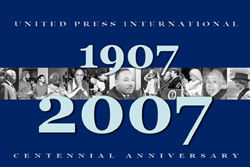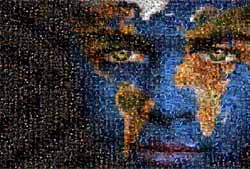1907 - 1910
1911 - 1920
1921 - 1930
1931 - 1940
1941 - 1950
1951 - 1960
1961 - 1970
1971 - 1980
1981 - 1990
1991 - 2000
2001 - Today
|
 |
UPI Archives
Sunday, Nov. 24, 1963
UPI reporter close as Ruby shot Oswald
By TERRANCE W. McGARRY
DALLAS, Nov. 24, 1963 (UPI) -- It was a struggle between a reporter's premonition and sleep, but the premonition won.
I was going to be off duty until 3 p.m. today, after spending two days in the turmoil following the president's assassination. I had gotten to sleep this morning at 4 a.m.
But before going to bed, another United Press International newsman -- Curtis Gans -- and myself agreed on one thing: Lee Harvey Oswald, a man who had incurred the hatred of a nation, was going to be transferred from the city jail to the custody of the county sheriff in a few hours. The time of the move had been publicly announced as 10 a.m.
It's a 10-block drive from the city jail to the sheriff's office. Precautions would be taken of course.
But if the extensive precautions taken failed to protect the life of a loved and respected president, what were the chances of the man police are sure killed him? Or did someone have an interest in keeping Oswald silent?
We arrived to find the jail building's corridors jammed with newsmen and photographers from all over the nation and the world: A small Japanese, an elegant Frenchman in a blue silk ascot.
The elevator from the jail descends into a small office in the basement. The office opens onto a short corridor. Two swinging glass doors separate it from a continuation of the same corridor that enters the garage in a T-shaped junction. The crossbar of the T slants up on either end toward the street.
The press milled around the area, waiting for Oswald to appear. It got later and later.
I began looking for a place to get a good view. Two heavy television cameras were standing on tall tripods behind one ramp. I went down and stood beside them.
I was standing about three feet below the level of the ramp. A green iron railing runs along the side of it.
About 11:15, a squad of hard-eyed plainclothesmen joined the platoon of uniformed officers in the garage. Most of the uniformed officers carried 12-gauge riot guns. The plainclothesmen unbuttoned their jackets for a swift draw in case of trouble.
They herded most of the newsmen and photographers out of the short corridor entering the garage where they had gathered. Most of them spilled into the garage and down the east wing of the T, where a large armored car had pulled up in the doorway and was framed in the sunlight.
The car was too big to be driven inside the building.
I was virtually alone on the west side of the junction, where Oswald would emerge under heavy guard in a few moments. The police seemed reluctant to ask the two heavy television cameras to move, and I suppose they thought I was part of the crew.
On my left, directly in front of the hall corridor entrance, was UPI photographer Frank Thompson. Further down, to his left and among the large body of the press corps was another UPI newsman -- Mike Rabun.
Once he left the jail office, Oswald would be in the open -- if you can call an underground garage in the heart of a big city police station open -- for the few seconds it would take him to walk the 30 yards or so to the waiting armored car. The sheriff's department planned to back the car up to a door to unload Oswald at his destination.
There was very little time, but it was all that was necessary.
At about 11:24, somebody shouted, "Oswald's coming."
There was a flurry of activity and two plainclothesmen moved swiftly through the swinging glass doors.
Behind them came the man whose name has filled the headlines and airwaves since Friday afternoon. There was a plainclothes detective on each side, grimly clutching his arm.
Oswald appeared calm. I never noticed whether he was manacled, I suppose he was.
I jumped up and clambered over the railing. As I stepped down on the other side, there was a swift brown blur.
Thompson said later the short, balding man in what seemed to be a brown suit raced right past him from the rear. I didn't see where he came from.
Oswald had just reached the junction of the T and started his turn to the right.
When I first saw the killer, he was piling into Oswald -- it seemed from slightly to Oswald's right -- in a half crouch.
There was a loud report. I couldn't see the pistol or any flash, because the gunman's back was to me.
I dashed toward the spot. Later on, I came back and paced off the scene. I was five steps from the spot when the shot sounded.
I never heard the gunman say a word. As at least six policemen fell on him, I could see Oswald slumping to the floor, his left arm across his middle.
One policeman grabbed the gunman's right arm. A small black revolver was clutched in his fist. Its muzzle waved back and forth, pointing up the west ramp where I was standing.
I backpedaled fast, trying to get out of the line of fire and still stay close to the action. Glancing quickly behind me to keep from tripping, I caught the silhouette of the policeman standing in the west entrance. He had drawn his pistol and was crouched in the center, taking aim down the ramp. I don't know whether he was aiming at me, or simply at the melee on the garage floor. I was between him and the spot where a pile of officers had succeeded in wresting the pistol from Oswald's killer.
I flattened myself against the wall with my arms straight out at my sides.
When I looked back, police were dragging off both Oswald and the man later identified as Jack Ruby, a Dallas nightclub owner.
I turned and sprinted around the corner. A friendly Dallas newsman was holding open a telephone line in a pay booth directly across from the metal-barred grill window of the jail office.
There was a still photographer and two movie cameramen in front of me. I think I knocked down the still photo man. I'm not sure.
I made it through the swinging doors with the two movie cameramen just as somebody shouted, "Close it off; don't let anybody leave."
I looked into the jail office. Police were huddled around both Ruby and Oswald, who were both on the floor. Then about 40 seconds later, police hauled Ruby to his feet. I caught a swift glimpse as they hurried him into the office elevator.
A stretcher came up for Oswald. His shirt was torn and as they rolled him past, I could see a small blue-ringed hole just below his ribcage on the left side. It didn't look like it was bleeding.
Oswald's head was bobbing back and forth as they wheeled him around the corner and I grabbed for the phone.
--
(Editor's note: Reporter Terrance W. McGarry was less than 10 feet away when Jack Ruby shot and fatally wounded Lee Harvey Oswald, the assassin of President John F. Kennedy. This is McGarry's story.)
Copyright 2007 by United Press International.
|


